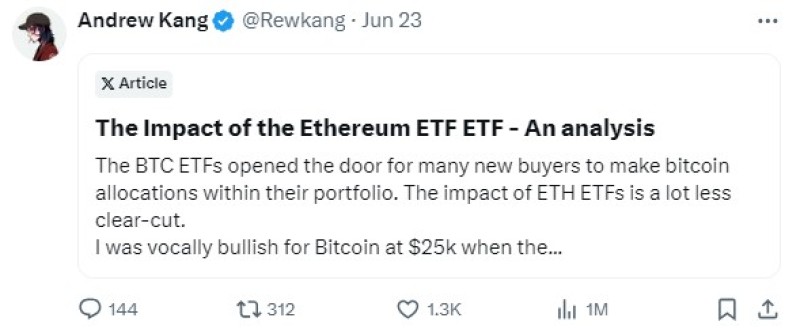Mechanism Capital's Andrew Kang predicts Ethereum (ETH) could plummet to $2,400 following the introduction of spot ETH ETFs, citing limited institutional interest and lackluster network economics.
Ethereum’s Potential Downturn Post-ETF Launch
Mechanism Capital’s Andrew Kang has voiced concerns about Ethereum’s price trajectory following the launch of spot Ether exchange-traded funds (ETFs). Kang predicts that ETH could drop to as low as $2,400, representing a nearly 30% decline from its current trading price of $3,410, according to CoinGecko.
Kang’s analysis, shared in a June 23 X post, suggests that unlike Bitcoin, Ether fails to attract substantial institutional interest. He argues that there are few incentives to convert spot Ether into ETF form, and the network’s cash flows have been unimpressive. Kang elaborated, “How much upside would an ETH ETF provide? I would argue not much. After the ETF launch, my expectation is $2,400 to $3,000.”

Comparative ETF Flows: Ether vs. Bitcoin
Kang believes that spot Ether ETFs will attract significantly less flow compared to spot Bitcoin ETFs. He estimates that Ether ETFs might only see 15% of the flows that Bitcoin ETFs have attracted, which falls within the 10–20% range estimated by Bloomberg ETF analysts Eric Balchunas and James Seyffart. With only $5 billion in new funds flowing into spot Bitcoin ETFs in the first six months, extrapolating this to Ethereum suggests a mere $840 million in “true” inflows.
Not everyone shares Kang’s bearish outlook. Industry analyst Patrick Scott, also known as Dynamo DeFi, told Cointelegraph Magazine that he expects Ether’s price to follow a similar directional movement as Bitcoin ETFs, though he doesn’t foresee Ether’s price doubling. Meanwhile, VanEck, an asset management firm, predicts that spot Ether ETFs could propel Ether to $22,000 by 2030.
Challenges and Opportunities for Ethereum
Kang argues that Ethereum’s pitch as a decentralized financial settlement layer, world computer, or Web3 app store, while compelling, is a tough sell given the data. He noted that Ethereum’s potential as a cash flow “machine” seemed more promising during the decentralized finance boom and the last non-fungible token cycle. However, with current metrics, Ethereum might appear as just another overpriced tech stock. Kang questioned, “At $1.5B 30d annualized revenue, a 300x PS ratio, negative earnings/PE ratio after inflation, how will analysts justify this price to their daddy's family office or their macro fund boss?”
The removal of staking from the proposed spot Ether ETFs may also deter investors. Despite early marketing efforts from approved Ethereum ETF applicants like Bitwise and VanEck, the surprise approval of these ETFs means issuers have less time to appeal to institutional investors. Kang acknowledged that financial institutions like BlackRock are making moves in the real-world asset tokenization space on Ethereum, but he remains uncertain about the impact on Ether’s price.
Kang predicts that the ETH/BTC price ratio could slide from 0.054 to as low as 0.035 over the next 12 months. However, he also speculates that a Bitcoin price rally to $100,000 in the next six to nine months could potentially drag Ether to a new all-time high in the process.
In conclusion, as Ethereum navigates the post-ETF launch landscape, market participants are left to weigh Kang’s cautionary outlook against more optimistic predictions, highlighting the ongoing debate over Ether’s future in the evolving crypto market.
 Peter Smith
Peter Smith

 Peter Smith
Peter Smith

